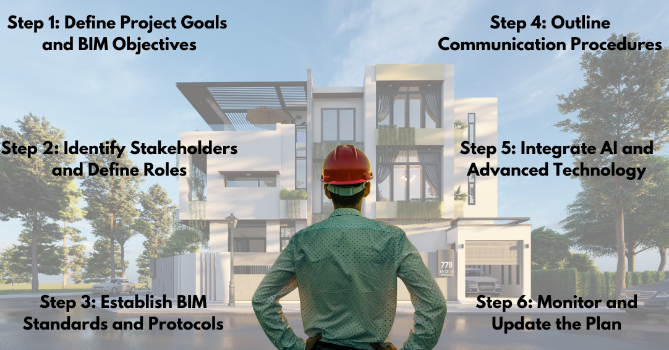.png)
Mastering BIM Execution Plans (BEP): A Step-by-Step Guide
Introduction
BIM, or Building Information Modeling, is changing how construction projects are managed. At the heart of this change is the BIM Execution Plan (BEP). A BEP is a key document that outlines the processes, standards, and tools used throughout a project. It keeps everyone on the same page, from architects to contractors, making sure the project runs smoothly. By creating a clear BEP, you can avoid delays, reduce confusion, and boost efficiency. This guide will help you understand the steps needed to create a strong BEP. With the right approach, your project can reach its goals faster and with fewer issues. Let’s get started on mastering your BEP.
Understanding BIM Execution Plan
A BIM Execution Plan (BEP) is a comprehensive guide developed at the start of a construction project. It explains how Building Information Modeling (BIM) will be used throughout the project's lifecycle. This plan outlines key details such as data exchange protocols, collaboration processes, and specific responsibilities of each team member. The BEP ensures that everyone—architects, engineers, contractors—follows the same strategy, working together smoothly. It doesn’t just cover the technical aspects but also aligns the project’s goals with real-world execution. By clearly defining processes, standards, and technologies early on, a BEP reduces confusion, avoids rework, and keeps the project on track. It's a vital tool that helps teams deliver results more efficiently, while ensuring the project stays within its budget and timeline. In short, a well-prepared BEP sets the foundation for a successful project.
Why is a BIM Execution Plan Important?
A BIM Execution Plan (BEP) is crucial for ensuring a smooth project from start to finish. It provides clarity, helping teams avoid confusion and miscommunication. By setting clear guidelines on data exchanges, file formats, and communication methods, a BEP keeps everyone aligned. This improves collaboration and ensures that all parties—architects, engineers, contractors—are working from the same playbook.

The benefits of a BEP go beyond communication. It also reduces rework by making processes more efficient and organized. With a solid plan in place, fewer mistakes are made, saving both time and money. Cost management improves because every team member knows their role and responsibilities from the beginning.
In today’s construction landscape, where AI and advanced technologies are often integrated with BIM, a BEP becomes even more valuable. It ensures that these tools are used properly, delivering better results by maximizing efficiency and minimizing errors. A well-executed BEP keeps projects on track, reduces delays, and helps meet budgets.
Key Components of a BIM Execution Plan
A BIM Execution Plan (BEP) includes several key components that guide a project from start to finish. These elements are essential for keeping the project on track and ensuring clarity among all team members.
Project Information and Goals: This section outlines the project's vision, objectives, and scope. It sets the foundation for the project, ensuring everyone knows the end goals and how to achieve them.
Roles and Responsibilities: Clearly defined roles are essential in any project. The BEP specifies the responsibilities of each stakeholder, from architects to contractors. Everyone knows their duties, reducing misunderstandings.
BIM Uses: The BEP explains how BIM will be used. This could involve design coordination, cost estimation, or facility management. Identifying BIM applications early ensures all parties are prepared to use the tools effectively.
Modeling Standards: Consistency is key in BIM. The BEP sets standards for the model’s structure, including file naming conventions, formats, and levels of detail. This helps create a uniform approach and reduces errors.
Technology and Tools: With the rise of AI and other advanced technologies, the BEP must specify which tools will be used for collaboration and model management. This ensures all team members are working with compatible and effective technology.
Documenting these components clearly prevents confusion and helps the project run smoothly, ensuring everyone knows how the work will be executed.
Step-by-Step Guide to Crafting a BIM Execution Plan
Creating a BIM Execution Plan (BEP) involves several important steps. Each step ensures the project is well-organized and ready for successful execution.
Step 1: Define Project Goals and BIM Objectives
Start by understanding the client’s vision. What are the goals of the project, and how will BIM help achieve them? Establish clear objectives for how BIM will be used, whether for design, cost control, or facility management. These objectives guide the entire project.

Step 2: Identify Stakeholders and Define Roles
Next, identify all team members and clearly define their roles. From architects to engineers to contractors, everyone must know their responsibilities. Document these roles in the BEP, especially with AI tools now helping to automate data handling and task management. This clarity helps avoid confusion later.
Step 3: Establish BIM Standards and Protocols
Set up the standards for how BIM will be used. This includes data exchange methods, modeling guidelines, and collaboration platforms. Make sure everyone follows the same rules for file formats and modeling practices to keep the project consistent.
Step 4: Outline Communication Procedures
Effective communication is key to any project. Define how teams will communicate—whether through specific file formats, regular model coordination meetings, or structured approval workflows. This ensures nothing gets lost in translation.
Step 5: Integrate AI and Advanced Technology
Leverage AI for tasks like clash detection and design optimization. AI can provide real-time insights, making the BEP more dynamic and effective.
Step 6: Monitor and Update the Plan
The BEP is a living document. Regularly review and update it as the project evolves, ensuring it stays aligned with new technologies and project changes.
Benefits of Using AI and Technology in BIM Execution Plans
AI and advanced technology can significantly boost the efficiency of a BIM Execution Plan (BEP). AI tools can automate time-consuming tasks like clash detection, progress tracking, and cost estimation. This automation speeds up workflows, allowing teams to make real-time decisions that keep the project moving smoothly. AI also helps predict potential delays or issues before they happen, giving teams a chance to resolve problems early. By integrating AI, the BEP becomes more flexible, responding quickly to changes on-site and adapting to new challenges. This not only saves time but also keeps the project on budget. In modern construction, where efficiency is key, using AI within a BEP makes a major difference in keeping projects on track and ensuring successful outcomes.
Conclusion: The Future of BIM Execution Plans
The construction industry is becoming increasingly digital, and BIM Execution Plans (BEPs) are evolving with it. Technologies like AI and machine learning are helping streamline processes and reduce errors, making projects more efficient. These tools ensure that projects are completed faster, stay on budget, and face fewer challenges along the way. Understanding how to create and execute a BEP is crucial for staying competitive in today’s construction world. As technology advances, mastering BEPs will be key to running successful projects in the future.